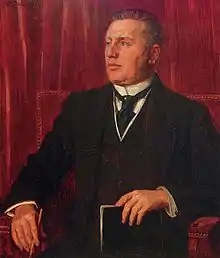Karl Haberstock
Karl Haberstock (born 19 June 1878 in Augsburg; died 6 September 1956 in Munich) was a Berlin art dealer who was a member of the degenerate art Disposal Commission.[1] Haberstock's name appears 60 times in the Art Looting Investigation Unit (ALIU) Reports 1945-1946 and ALIU Red Flag Names List and Index.[2]

Aryanization
Among Haberstock's many spoliation activities documented by the ALIU was the aryanization, with the assistance of Baron von Poellnitz and Roger Louis Adolphe Dequoy, of the Wildenstein firm which then continued to trade.[3]
According to historian Jonathan Petropoulos "Haberstock, despite selling works to Göring and other Nazi elite, owed his status to Hitler alone."[4]
At the end of World War II Haberstock was arrested for his Nazi art looting activities, however he testified against Hermann Göring at the Nuremberg Trials and was subsequently released.[5] In the 1950s he opened a gallery in Munich living in the apartment below that of the director of Göring's art collection, Walter Andreas Hofer.[6]
None of this history has interfered with the reverence that his home city of Augsburg still holds for Haberstock. The portrait shown in this entry hangs prominently in the city's leading Art Museum, the Schaezlerpalais, and a minor residential street bears his name.
References
- Petropoulos, Jonathan. (1996). Art as Politics in the Third Reich. Chapel Hill: University of North Carolina Press. p. 318. ISBN 978-0-8078-4809-8.
- Michael Hussey, Michael J. Kurtz, and Greg Bradsher. "Art Looting Intelligence Unit (ALIU) Reports 1945-1946 and ALIU Red Flag Names List and Index". LootedArt.com. USS Office of Strategic Services. Retrieved 8 May 2017.CS1 maint: multiple names: authors list (link)
- Michael Hussey, Michael J. Kurtz, and Greg Bradsher. "Art Looting Intelligence Unit (ALIU) Reports 1945-1946 and ALIU Red Flag Names List and Index". LootedArt.com. USS Office of Strategic Services. Retrieved 8 May 2017.CS1 maint: multiple names: authors list (link)
- Petropoulos, Jonathan (30 March 2000). The Faustian Bargain: The Art World in Nazi Germany. Penguin Books Ltd. p. 86. ISBN 978-0140290356. Retrieved 7 June 2017.
- Bohlen, Celestine (21 November 2000). "National Gallery to Return a Family's Painting Looted by the Nazis". New York Times. New York Times. Retrieved 7 June 2017.
- Petropoulos, Jonathan. "Inside the Secret Market for Nazi-Looted Art". Art News. Art News. Retrieved 7 June 2017.
External links
- http://www.spiegel.de/international/germany/hildebrand-gurlitt-and-his-dubious-dealings-with-nazi-looted-art-a-940625.html
- 1946 Detailed Interrogation Report N° 13 Karl Haberstock - United States War Department
- Bridges from the Reich: The Importance of Émigré Art Dealers as Reflected in the Case Studies of Curt Valentin and Otto Kallir–Nirenstein
- Hermann Goring and the Nazi Art Collection: The Looting of Europe's Art Treasures and Their Dispersal After World War II